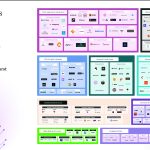
For businesses, a .com domain has always been the holy grail of domain suffixes. Until relatively recently it was one of only a few TLD’s widely available but that is no longer the case.
For artists and art organisations seeking inspiration for their online presence, the recent creation of the .art top level domain (TLD) may be a game changer. The proudly-named art.art website has a list of early adopters of this domain extension, including the Magritte Foundation, the Tate Modern and the Guggenheim.
The .art domain suffix is just one of an ever-expanding group of TLDs. It appears alongside other recently created extensions like .shopping, .boats and even .lifeinsurance. With so many TLDs to choose from, some of them highly specialised for different areas, will the reign of the ubiquitous .com come to an end? And should businesses trade in their .com websites for new, more descriptive alternatives?
What’s the deal with TLDs, anyway?
There are nearly 900 top level domain names available. Each of them is designed to say something about the website it hosts. An obvious example is .art, which definitively indicates that the website will have something to do with the art industry (though if a certain 60s folk icon registers the domain name “garfunkel.art” I certainly wouldn’t complain).
There are more established TLDs too. The .gov and .edu domain suffixes have been around since the dawn of the world wide web, and users trust them to indicate authoritative government or educational websites. As well as these, there are location-based TLDs, such as .uk or even .london if a site wants to be more specific.
Despite the plethora of names to choose from, the majority of websites still go by the simple .com. This has led the US Department of Commerce to loudly campaign for a domain name cleanup, urging websites to switch to one of the new custom TLDs. The Telegraph has even pondered aloud whether .com will soon become obsolete, on the suffix’s 30th birthday no less.
Domain suffixes that prove authenticity like .gov and .org are widely used. As are national domain names like .de, .fr and .co.uk. But any web user will see that .com greatly outnumbers them. According to figures from Domain Punch, the second most common TLD (the equally nondescript “.net”) has ten times fewer registered sites than .com. which has 126,974,830 and counting. Despite the Telegraph thought piece, varied TLDs have not caught on, specifically for businesses. And there are many reasons why.
Why businesses still prefer .com domain names
Though some are adopting the new TLDs, the perceived advantages of .com keep it at the head of the field. Online branding agency Novanym have called .com the “perfect” TLD and the Golden Domain. Their reasoning is this: all the big brands use .com, therefore any business that plans on entering the big leagues must do the same. They even suggest that investors will see an alternative TLD as a red flag, suggesting the owner does not take branding as seriously as it should.
There are other benefits to .com aside from projecting confidence. SEO Metrics found that over 75% of internet links lead to .com domains, which tells Google’s crawlers to take this domain extension more seriously. They also point to the increasing importance of branding to SEO, with businesses with stronger branding and awareness almost always ranking above competitors in search engine results. Like Novanym, SEO Metrics suggest .com makes for much stronger branding.
Will these new suffixes tempt businesses away from .com?
With the recent release of .art, The Guardian speculated that many artists and art institutions will be attracted to the new TLD because of its implied prestige and authenticity. Artists are keen to mark out their creative credentials whenever they can, so having “.art” at the end of their website is an effective way to do that.
Other domain suffixes are less likely to have that effect on their niche. Papa John’s, for example, is unlikely to trade in its current .com domain for the more appropriate “.pizza” any time soon. And Bavarian businesses are not likely to swap their broader .com domains for the more geographically descriptive “.bayern”.
Until descriptive TLDs offer more benefits than simple organisation, .com will remain the top domain for businesses.












